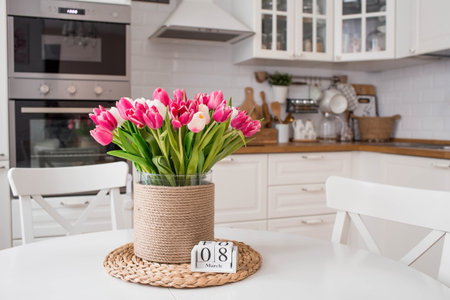1. Understanding Feng Shui in the American Home
Feng Shui, an ancient Chinese practice focused on harmonizing individuals with their environment, has found new relevance in American homes—especially in communal spaces like the dining room. At its core, Feng Shui emphasizes the flow of energy (or “chi”) to promote well-being, prosperity, and connection. While rooted in Eastern philosophy, these principles can be seamlessly adapted to suit diverse American lifestyles and interiors, blending tradition with modern comfort.
For many Americans, the dining room is more than just a place to eat; it’s where families gather for daily meals, host friends for holiday feasts, and create lasting memories. By applying Feng Shui concepts thoughtfully, you can set the stage for a welcoming atmosphere that fosters togetherness and abundance right at the heart of your home.
Key Feng Shui Principles Adapted for American Dining Rooms
| Traditional Principle | American Adaptation |
|---|---|
| Balance of Elements (Wood, Fire, Earth, Metal, Water) | Mixing natural materials (wooden tables), warm lighting (candles or pendant lights), earth-toned decor, metal accents (cutlery or light fixtures), and subtle water features (artwork or small fountains) |
| Open Energy Flow | Clear pathways around the table, uncluttered surfaces, and strategic furniture placement for easy movement |
| Symbolism of Abundance | Displaying fruit bowls or fresh flowers as centerpieces to signify prosperity and welcome guests |
| Inviting Colors | Utilizing warm and neutral tones that feel inviting while reflecting personal taste and current design trends |
Setting the Tone for a Welcoming Dining Room
The goal is to create a dining space that feels both intentional and inviting—a place where everyone feels comfortable lingering over a meal. Whether you live in a suburban house, city apartment, or rural retreat, integrating Feng Shui into your dining room design can enhance social bonds and encourage positive energy flow. Start by assessing your space with an open mind: consider how color choices, furniture arrangement, and decorative elements might impact the mood and function of the room. Small adjustments inspired by Feng Shui can lead to big changes in how your dining room looks and feels—turning it into a true heart of your home.
Optimal Dining Room Layouts for Connection
The arrangement of your dining room plays a vital role in how energy flows, impacting both the atmosphere and the quality of interactions among family and guests. In Feng Shui, thoughtful layouts can foster togetherness, open communication, and an overall sense of abundance—values that resonate deeply within American homes where the dining room often serves as the heart of family gatherings and celebrations.
Table Placement: Anchoring Positive Energy
Positioning your dining table is the first step toward creating a harmonious environment. Ideally, place the table in the center of the room or where it feels balanced, avoiding tight corners or spaces directly against walls. This arrangement encourages equal participation and makes everyone feel included. If possible, ensure there is enough space around all sides for comfortable movement, supporting both physical and energetic flow.
Seating Arrangements: Enhancing Connection
The way you seat guests matters. Round or oval tables are considered most auspicious for connection since they allow everyone to see each other and encourage conversation. Rectangular tables are common in American homes; if using one, consider placing the head seats facing the entryway to symbolize leadership and welcome. Avoid seating arrangements where someone’s back is directly to a door or window, as this may cause discomfort or distract from meaningful interaction.
Common Energy Blockages and Solutions
| Blockage | Impact | Feng Shui Solution |
|---|---|---|
| Cluttered pathways | Restricts movement and energy flow | Keep walkways clear; remove unnecessary furniture |
| Sharp corners (“poison arrows”) | Create tension among diners | Soften with rounded furniture or plants |
| Direct alignment with front door | Dissipates positive energy quickly | Add a divider or large plant between door and table |
| Poor lighting | Dampens mood and engagement | Use warm overhead lights or add candles for ambiance |
By thoughtfully considering these layout elements, you can transform your dining room into a welcoming space that supports family connection, open dialogue, and a lasting sense of abundance—a true reflection of both Feng Shui principles and cherished American values.
![]()
3. Color Palettes and Decor for Abundance
Creating a dining room that radiates prosperity and warmth starts with intentional color choices, thoughtful textures, and meaningful decor. In Feng Shui, colors are more than just aesthetic—they influence energy flow and emotional well-being. To align with American design preferences while embracing abundance, choose colors and accents that evoke comfort and inclusivity.
Choosing Colors That Foster Prosperity
Earthy tones like warm beige, soft golds, rich greens, and deep blues are excellent choices for American dining rooms. These hues ground the space and invite feelings of stability and abundance. For a touch of vibrancy, consider accents in burnt orange or terracotta, which symbolize vitality without overwhelming the senses.
| Color | Feng Shui Meaning | How It Resonates in U.S. Homes |
|---|---|---|
| Warm Beige & Cream | Stability & Comfort | Classic, inviting, easy to pair with other decor |
| Soft Gold | Wealth & Opulence | Adds a subtle luxurious touch without being flashy |
| Sage or Olive Green | Growth & Renewal | Brings nature indoors, pairs well with wood furniture |
| Navy Blue | Calm & Trust | A sophisticated neutral popular in modern homes |
Textures: Layering Warmth and Depth
The right textures create a welcoming atmosphere where guests feel at ease. Incorporate soft textiles like linen table runners, cotton napkins, or plush seat cushions for comfort. Wood finishes—whether polished or rustic—bring natural grounding energy and resonate with classic American style. A textured area rug can also help define the dining area within an open-plan layout.
Accessible Decor Tips:
- Add mirrors strategically to reflect light and amplify the sense of spaciousness—a Feng Shui tip that works beautifully in American homes seeking an open feel.
- Display a centerpiece bowl filled with seasonal fruits; this not only symbolizes abundance but also encourages family-style dining traditions cherished in the U.S.
- Choose wall art that depicts gatherings or nature scenes to reinforce togetherness and growth.
Cultivating Prosperity Through Thoughtful Choices
You don’t need to make major renovations to achieve a prosperous dining room. Simple updates—like swapping out table linens for earth-tone options or incorporating a statement mirror—can transform the space’s energy. By blending Feng Shui principles with accessible, culturally resonant design elements, your dining room becomes a true heart of the home where abundance naturally flourishes.
4. Lighting the Way to Nourishment
Lighting plays a pivotal role in dining room Feng Shui, shaping not only the energy but also the mood and connection among those who gather at your table. In American homes, where the dining room often doubles as a place for celebration, conversation, and everyday bonding, creating an atmosphere that is both warm and vibrant can foster togetherness and abundance.
Natural vs. Artificial Light: Setting the Tone
| Lighting Type | Feng Shui Benefits | Best Practices |
|---|---|---|
| Natural Light | Promotes vitality, positivity, and growth; enhances appetite and mood | Keep windows clean and unobstructed; use sheer curtains; position mirrors to reflect sunlight |
| Artificial Light | Maintains warmth during evenings or cloudy days; sets the ambiance for different occasions | Select dimmable fixtures; choose warm-toned bulbs; layer lighting with overheads, sconces, and lamps |
Strategies for Creating a Bright and Inviting Atmosphere
- Layer Your Lighting: Combine ambient (overhead), task (buffet lamps), and accent (candles or wall sconces) lighting to adapt the mood from casual family meals to festive gatherings.
- Choose Warm Tones: Soft white or warm LED bulbs mimic natural sunlight, making your space feel more welcoming and enhancing the color of food.
- Avoid Harsh Shadows: Position lights so they don’t cast unflattering shadows over faces or food. A chandelier centered above the dining table is a classic choice in many American homes.
The Feng Shui Effect on Togetherness & Abundance
The right lighting encourages guests to linger at the table, fueling meaningful conversations and deeper connections—hallmarks of an abundant home life. By thoughtfully balancing natural daylight with adjustable artificial light sources, you create a dining area that feels open, nourishing, and conducive to shared joy.
5. Symbolic Elements: Bringing Family & Friends Together
In American homes, the dining room often serves as the heart of family gatherings and celebrations with friends. By incorporating meaningful objects and art into this space, you can elevate its energy and enhance the sense of unity and abundance during daily meals. Thoughtful placement of symbolic items not only beautifies your dining room but also supports positive Feng Shui, reinforcing harmony and good fortune at every gathering.
Meaningful Objects for Unity & Good Fortune
Selecting the right objects is essential in creating a welcoming atmosphere. Here are some popular choices and their symbolic meanings:
| Object/Art | Symbolic Meaning | Feng Shui Benefit |
|---|---|---|
| Mirrors | Reflects abundance, doubles prosperity | Expands space and light, enhances togetherness |
| Centerpieces (e.g., fresh flowers, fruit bowls) | Vitality, growth, health | Attracts positive energy and prosperity to the table |
| Family Photos | Bonds, shared memories, lineage | Reinforces unity and belonging among diners |
| Candles or Lanterns | Warmth, illumination, hope | Creates a cozy ambiance and encourages heartfelt conversations |
| Sculptures or Artworks of Togetherness (e.g., group figures, trees) | Connection, rootedness, support | Reminds everyone of mutual support and unity |
Best Practices for Displaying Symbolic Elements
- Mirrors: Place a mirror on a wall where it reflects the dining table to symbolize doubling your blessings. Avoid mirrors facing sharp corners or clutter.
- Centerpieces: Choose round or oval shapes to encourage inclusivity; refresh flowers or fruits regularly to maintain vibrant energy.
- Family Photos: Arrange them tastefully on a nearby sideboard or gallery wall—avoid placing directly on the dining table to keep meal spaces uncluttered.
- Candles/Lanterns: Use unscented options during meals for comfort without overpowering food aromas; cluster in odd numbers for balance.
- Themed Artworks: Hang pieces that depict groups or natural abundance, like harvest scenes or flourishing trees, to inspire gratitude and connection.
Tying It All Together in Daily Rituals
The strategic inclusion of these symbolic elements transforms ordinary dining into meaningful rituals. Whether it’s lighting candles before dinner or sharing stories over a table adorned with cherished photos, these practices cultivate an environment where family and friends feel valued and connected—making every meal an opportunity for togetherness and abundance.
6. Maintaining Flow and Organization
To truly harness the benefits of Feng Shui in your dining room, maintaining a sense of flow and organization is essential. A clutter-free space not only promotes a harmonious atmosphere but also encourages positive energy—or “chi”—to circulate throughout the heart of your home. Here are some practical tips to help you achieve a well-balanced and organized dining area that keeps mealtimes enjoyable and stress-free.
Declutter with Purpose
Start by assessing what truly belongs in your dining room. Excess items like mail, paperwork, or random knick-knacks can disrupt the energy flow. Make it a habit to clear off the dining table after each use and keep surfaces free from unnecessary objects. Use storage solutions such as sideboards or cabinets to stow away tableware, linens, or seasonal décor when not in use.
Organizational Strategies for Your Dining Room
| Area | Common Clutter | Feng Shui Solution |
|---|---|---|
| Dining Table | Papers, electronics, decor overload | Keep centerpiece simple; remove non-dining items daily |
| Chairs & Corners | Bags, coats, shoes | Add hooks or a small bench nearby; keep walkways clear |
| Buffet/Sideboard | Unused dishes, serving ware overflow | Store only frequently used items; rotate décor seasonally |
| Walls/Shelves | Too many photos/artwork creating visual chaos | Select meaningful pieces; leave some open space for balance |
Create Smooth Energy Flow (Chi)
The arrangement of furniture has a big impact on how energy moves through your dining room. Avoid blocking entryways or cramming chairs too close together; guests should be able to move freely around the table. Position chairs so everyone has an unobstructed view of the door if possible—a classic Feng Shui principle that fosters security and openness during meals.
Tips for Balanced Dining Room Layouts
- Avoid sharp corners: Round or oval tables encourage better chi circulation than square or rectangular ones with sharp edges.
- Leave pathways clear: Ensure there’s enough space to comfortably walk around all sides of the table.
- Balance elements: Incorporate earth tones, natural textures, and plants to ground the space and invite abundance.
- Edit regularly: Revisit your layout seasonally to adjust for changing needs or festive occasions.
The Bottom Line: Consistency is Key
The secret to keeping your dining room inviting and energetically balanced is regular attention. By decluttering with intention, organizing smartly, and ensuring smooth physical and energetic flow, you set the stage for joyful gatherings and abundant meals in the true heart of your home.
7. Seasonal Feng Shui Touches
Keeping your dining room’s Feng Shui fresh and vibrant throughout the year is easy when you incorporate simple, seasonal updates inspired by American holidays and traditions. These small changes not only rejuvenate the energy in your space but also help your family stay connected to the rhythms of the year, fostering a sense of togetherness and abundance that aligns with both Feng Shui principles and American cultural values.
Seasonal Inspiration for Dining Room Feng Shui
By tuning into the spirit of each season, you can use colors, materials, and symbolic décor to create an inviting atmosphere in your dining room. Here are some ideas aligned with major American holidays:
| Season/Holiday | Feng Shui Update | Symbolic Meaning |
|---|---|---|
| Spring (Easter, Mother’s Day) | Add pastel-colored table linens, fresh flowers, or a bowl of eggs | Renewal, growth, new beginnings |
| Summer (Fourth of July) | Use red, white, and blue accents; incorporate sunflowers or patriotic centerpieces | Celebration, freedom, community spirit |
| Autumn (Thanksgiving) | Decorate with gourds, pumpkins, warm-toned candles, and harvest-themed runners | Gratitude, abundance, family unity |
| Winter (Christmas, Hanukkah) | Add evergreens, gold or silver accents, and twinkling lights or candles | Warmth, hope, festivity |
Simple Tips for Year-Round Energy Refreshing
- Rotate Centerpieces: Swap out your centerpiece for one that reflects the current season or holiday.
- Update Tableware: Use different placemats or dishware sets to mirror the time of year.
- Scented Candles: Choose scents that evoke seasonal feelings—like cinnamon in autumn or citrus in summer.
- Naturally Inspired Décor: Incorporate items like pinecones in winter or seashells in summer for an organic touch.
The Power of Intention
No matter how you choose to update your dining room for the season, do so with intention. In Feng Shui—and in American homes—thoughtful touches show care for your loved ones and reinforce a welcoming environment where everyone feels valued. These mindful shifts keep the energy flowing smoothly through the heart of your home all year long.


